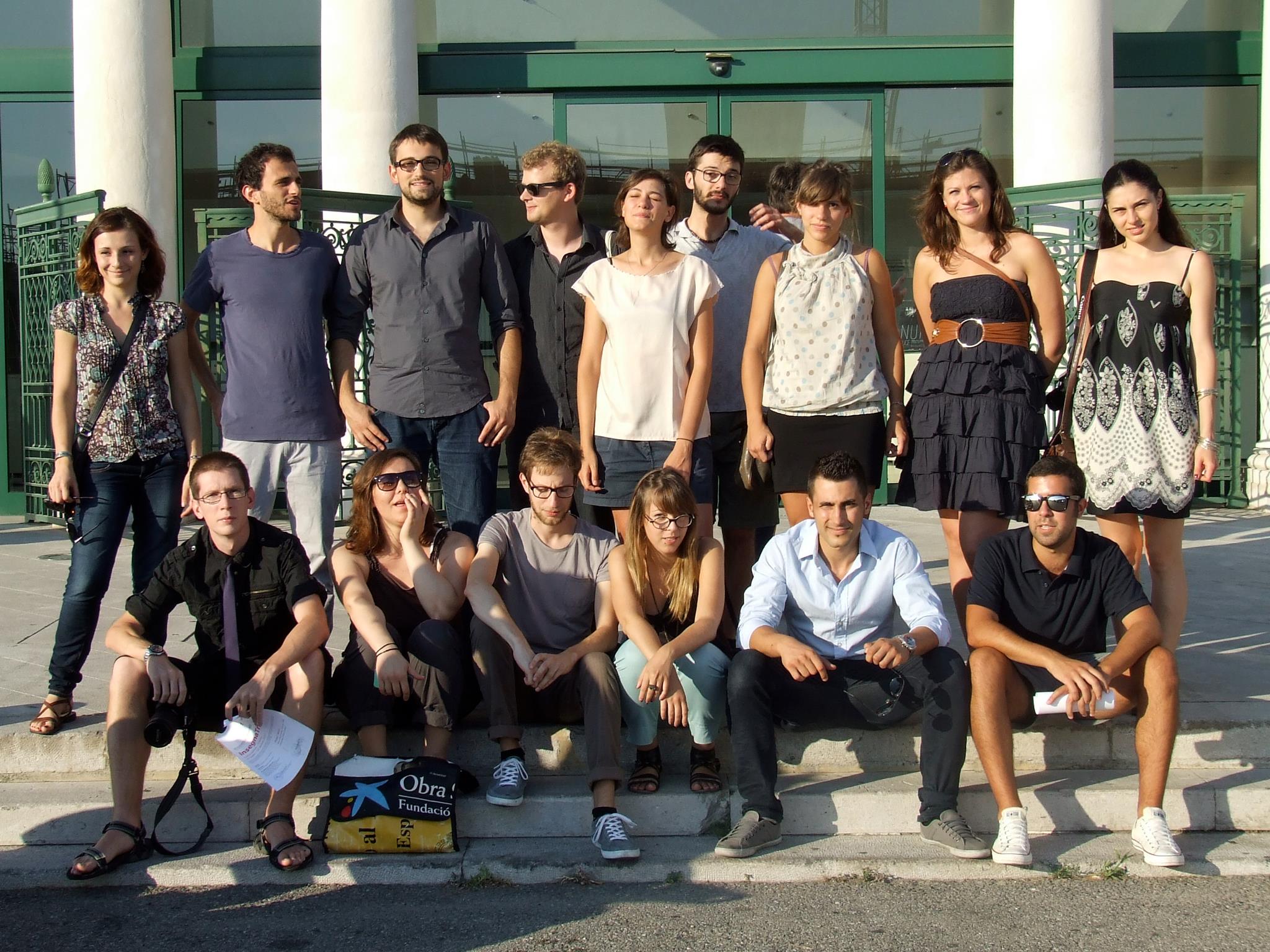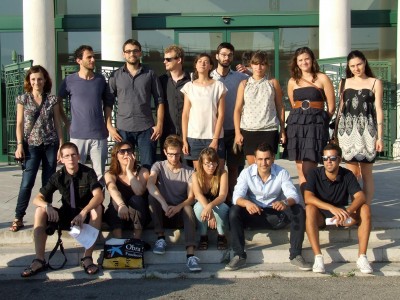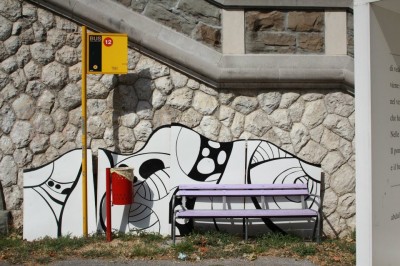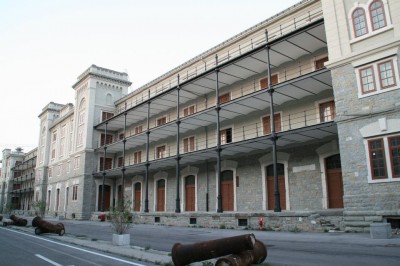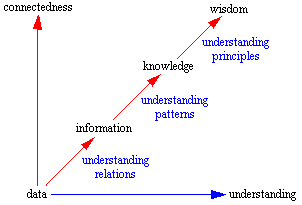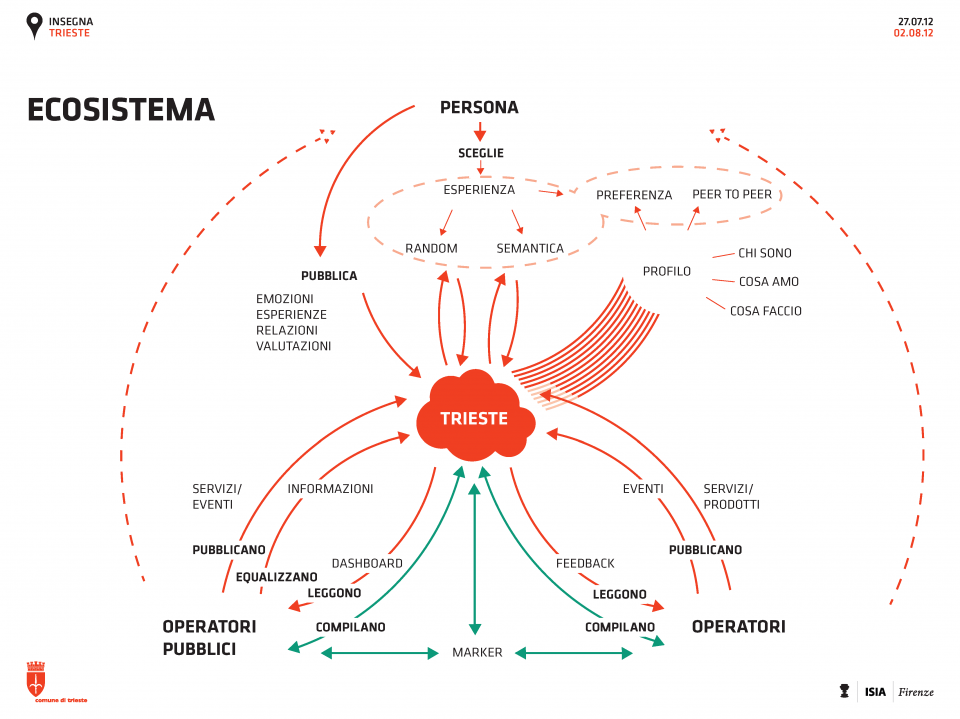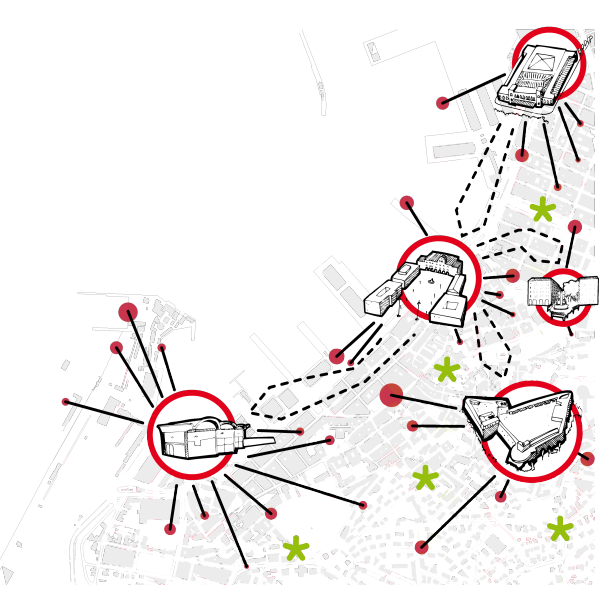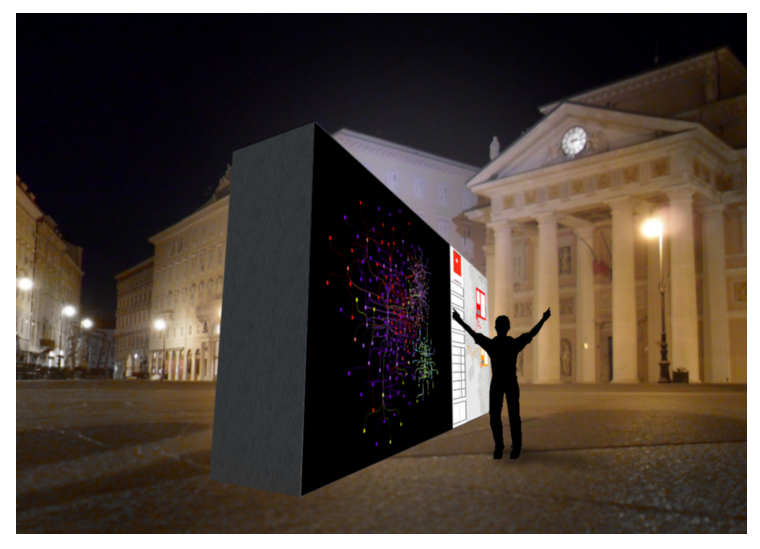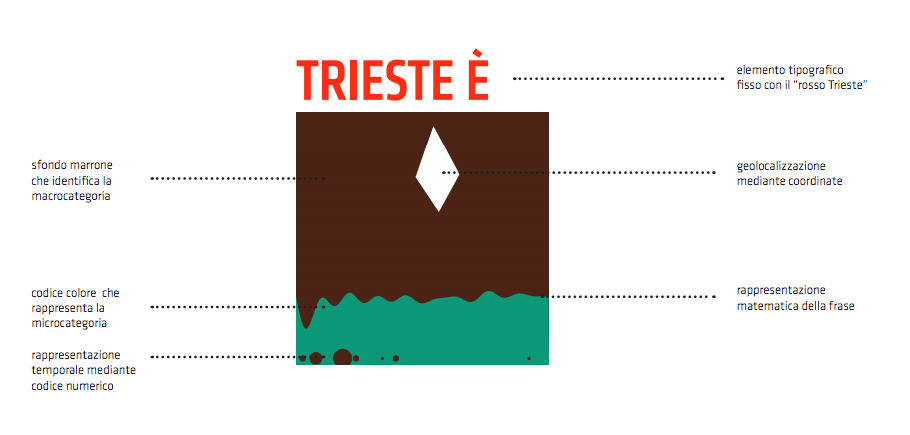Just back from Trieste, where we held an intense workshop about the re-design of the city’s urban communication.
The workshop has spread out over a whole week.
The first day we met the city and regional institutions (with many thanks to the counselors Fabio Omero and Elena Marchigiani who were with us for the whole day filled with presentations and talks, and who also have been a pleasant, informing presence during the next days of the workshop), who presented us with the global scenario of the city of Trieste and its region: a city dedicated to wellness and better life, capable of uniting the beauty of its multi-cultural history (the nearby international border and its beautiful histories of permeability and cultural remix was ever present and a beautiful source of narratives and of peculiar points of view) to the wealth of traditions, of food, wines, nature and innovation.
Trieste was painted as a “city with no single center“, a city which does not benefit from a massive, single attraction which could be used as driver for turism and development (e.g.: a colosseum), but a city with hundreds of different centers, based on experiences and well-being, on the hundreds of cultural associations, citizen groups, on the beautiful seaside, on the parks, castles, belvedere and spots for relaxed socialization, ready to be reinvented to re-conceptualize the city’s tourism and daily life.
This analysis was supported by the regional counselors for Turism, who described a rapidly developing sector, but who also wished to highlight how the region had been focusing on a multiplicity of different turisms (from turism to turisms) which could combine the necessities of large operators (e.g.: large congresses and tour operators) to the ones of the hundreds of different niches, aiming at realizing experiences for non-conventional turists, for amateurs, lovers, sport freaks and more.
The next two days we were taken for a walking tour of the many paradoxes of the city of Trieste by the Manifetso2020 association, taking us from the ex-OPP, the old asylum which is now one of the possible objectives of a new era of city projects, with its beautiful spaces up the hills and unused buildings full of history, down to the old port, where
an incredible number of practically abandoned buildings, clear example of industrial archaeology, are ready to host events, projects, fairs, concerts, exhibits and shows.
All the while we have been able to experience the peculiarities of the city, such as the characteristic ways in which the go to the beach, along the coastal roads of the Barcola with the typical Topolini buildings.
Having explored the city and its peculiarities, we set forth to confront with our task: the re-design of Trieste’s urban communication.
To do this, we followed a co-creative approach, in which many stages of expression merged into shared, collaborative sessions during which the overall project emerged.
Our high-level objective:
- layout the Information Architecture of the city
- design a solution which would bring benefit to tourism(s) and to the daily lives of the citizens
- design the navigation system of the city, in both its static and dynamic elements
- use ubiquitous technologies to create bridges between digital and analog realities, opening up the city to digital information, to social networks and to the emergence of user-generated content
QUESTIONS
How do you use a city without a center?
How is it possible to optimize, promote, develop, engineer or architect, in formal, manageable ways, a place with so many interpretations and with an identity which is disseminated among people, groups, associations, organizations, places and times?
Who are the city’s dwellers?
What do they desire? What do they want to do? Which experiences do they want to live?
How do they search and find the services they need to satisfy their day-to-day needs?
Where and how do they want to act?
Who do they want to meet?
How are their conversations made? How are their relations structured?
Which experiences do they dream about? Which ones do they not yet know they want?
Which information do they need when they are far?
Which ones while they are arriving in Trieste?
Which ones when they arrive?
Which information do they need when they stop in the city for one minute, one hour, one day, one month of for the rest of their life, for tourism, life, work, family, desire, emotions, passions, or science?
How can you navigate the city from the middle of a white square, or from a desert park atop the city, or from the walls of a castle, or from the spaces of an enormous grey building, or from the sidewalk at the port, or from a large avenue which traverses buildings of industrial archeology?
How is the navigation system of the city made? How can it make information readable, visible and accessible?
How can you transform Trieste into a semantic city?
How is the Information Architecture of the city of Trieste made?
Information Architecture
This was probably the most relevant diagram we used during the workshop.
The idea of bringing it to life by designing a novel system of urban communication and information has proven to be a challenging task.
Most urban signage do not go beyond the level of information: they assemble data about locations, opening times, types of venues etc to create signs which show useful information in the most readable, accessible way.
What we imagined for the city of Trieste was quite different.
We imagined using the opportunities offered by technologies and networks to go beyond information and to achieve knowledge and wisdom.
For example, city signage could be the portal for emergent publishing processes which would benefit from the constant production of content and commentaries by citizens and tourists on social networks: dedicated systems could be used to find patterns in people’s expressions and behaviors, thus producing usable knowledge which could be made accessible there, from the sign.
Obviously, technologies would be required to access these kinds of signs, too. And, thus, specific focus was dedicated to the issues of Digital Divide and Digital Inclusion, imagining ways in which people who did not own devices such as smartphones or did not know how to use them, could benefit from the same functionalities.
What we aimed for was a complete navigation system for the city.
The idea was also to use signage to enact the semantic city, in which the semantic relationships between venues, services, events and opportunities would be visible, readable and accessible.
The City as a Platform
Trieste is: the place for opportunity; of indetermination and, thus, possibility; of the small, comfortable, diffused; relational, colloquial; precise and complex; planned, functional and organized; the place of boundaries and of their permeability; of free contamination and of locked drawers.
According to these interpretations, Trieste is a natural platform for human expression, just like the Network.
The Network is not a Technology, but a place for expression, for relation, for communication and possibility.
It’s a place where no spectators exist: in the Network everyone is a performer.
Choosing, connecting, looking, conversing, recognizing and interacting: everything in the Network becomes construction.
Anything we do becomes a creation of maps of relations, tastes, meanings, affinities.
From consumers to cultural producers, disseminated in time and space, and connected by transforming links, multiple and emergent.
The Network has defined its models to deal with this expressive and creative modality.
The model of the Long Tail, defined in 2004 by Chris Anderson, has been able to effectively describe the economic life of this reality.
Here, a high frequency and amplitude population is followed by a low frequency/amplitude one.
Using the Amazon.com website as a typical example, the market is composed by a distribution of agents in which few publications selling millions of copies sit side-by-side with millions of other publications selling only a few (or even one) of them.
Far from classical business models, mainly dedicated to promoting few best-seller products and to the substantial exclusion of niches, the Long Tail is a polyphonic marketplace, which is able to valorize (and monetize) in extreme ways the productions of the smaller operators and to engage cultural niches.
Operators such as Amazon.com get as much as 60% of their profits from the possibility to simultaneously access hundreds of thousands of niche markets.
In this scenario operators become platforms for expression used by small actors, cultural producers, re-combiners, remixers, micro-curators of niche markets, fetishes and specialities, to diffuse and distribute their own vision.
The Long Tail is an ecosystem in its fullest definition: every actor contributes to the balance and well-being of the environment, performing its life-style and relations.
How is a Long Tail City made?
We offered a vision of the city of Trieste as a City-Platform, able to offering spaces, times, functionalities and opportunities to all the actors of the Long Tail – for tourism and citizenship–.
A city which is able to promote both the strategies and policies of large operators, and the ones of niche operators who, from within the city and from the diffusion of the Network, can invent, design, develop, communicate, offer and manage their product and services, referring to the passions, desires, visions, relations and imaginaries of their natural audiences.
A City Platform which can offer tools to operators of any size, and to transform people in performers: tourist performers; citizen performers; consumer performers; desiring and willing to live the experiences of the city and to give back their emotions, comments, rankings, orientations, suggestions, relations.
A City Platform in which data and information, brought into the ecosystem by private and public operators as well as by citizens and tourists, interweave producing knowledge and wisdom.
A City Platform in which recombining the city resources all actors of the Long Tail can express themselves: from large operators and the possibility to create supply chains and organization; to niche operators and the possibility to interconnect the resources of the city to express themselves and create fluxus and convergence.
Operators are able to publish all of their initiatives into the ecosystem: every published element – hotels, initiatives, events, restaurants… – is associated to a series of information and meta-data, allowing for its classification into the Information Architecture of the city.
Operators can describe the relations running between elements, thus creating the semantic city.
Each element is automatically associated to a sign, a unique marker that allows identifying it (two different elements will have different markers), and to access Augmented Reality content through it, and the element’s digital data, in real-time.
The marker is a generative visual sign which embeds the main information elements: the title, location, timeframe and classification.
On the other side of the diagram, people (citizens, residents, tourists) benefit from different ways with which to navigate the city.
Some of them allow them to navigate among all available elements: in semantic ways, surfing the information architecture, or pseudo-random ways.
Some other ways allow people to limit their scope. Every user can, in fact, personalize his/her own experience of the city and the ecosystem: explicitly, by configuring tastes and desires; implicitly, by using and taking part to the ecosystem, establishing affinities and differences which can be used semi-algorithmically as filters to suggest matches and possible interests.
Once an experience is over, people can enrich the ecosystem by publishing experiences, rankings, feedbacks, emotions, images and videos.
Operators can benefit from a dashboard mode through which they can observe the life of the city, thus being able to equalize parameters to optimize experiences and people’s engagement.
Urban Ecosystem
Of the many things proposed during the workshop, three have seemed to us as being outstanding:
- the idea of the moving center
- the open source city and the development kit
- the generative visual identity
The city of Trieste does not have a widely recognized landmark (such as the Colosseum in Rome) which can be immediately associated as its city center.
Furthermore, much of its richness is disseminated across its territory, and distributed throughout its historical center and its peripheries, which host architectures, parks and occasions for traditions, entertainment, good food and peculiar experiences.
The idea of creating a fixed centre did not obviously match this city configuration.
This is the reason why we chose to describe a moving center.
A movable landmark represents in real-time the life of the ecosystem of the city of Trieste. A visual map and a geographical map sit side by side and can be interacted with by touch and gestures to navigate the events, services, concerts, curiosities as well as the user-generated information.
A monument to the digital life of the city.
The landmark can be moved around the city: from time to time the administration chooses in which neighborhood to place it, fostering development of all the territories which make up the city, and establishing opportunities for novel events, paths throughout the city, unexpected traversals and, in general, having a tool which can be used to shift the focus of attention in the city together with the strategies for local and community development.
The landmark represents the life of the city: citizens living nearby it can benefit from the shifted focus of attention and, on top of that, feel their neighborhood valued and appreciated.
The movable center of the city opens up architecture and urbanism, turning it into an open, participatory flow.
The idea of the Experience Spots goes further in this direction.
Experience Spots are low-cost devices which implement micro-sensorial experiences which are disseminated throughout the city.
Designed as small boxes which are easily attached in most places, Experience Spots show minimal information like a certain environmental parameter, the density of presence in a certain spot of the city, or the speed of the Bora wind in the sidewalk along the sea. Or they can offer opportunities for minimal forms of interaction: a microphone into which to speak to leave a message to the next city dweller; a speaker from which to listen to the sound of another part of the city; a USB key sticking out of a wall onto which to leave sounds, videos or secret messages to other citizens; a real-time, city wide intercom, from which to communicate with other citizens somewhere else in the city; a single button creating some peculiar audio/visual effect; a minimal information visualization.
Experience Spots create a disseminated narrative of interactive experiences throughout the city: each one of them is made from a low cost device which is controlled by a street-computer which interconnects them to the city-cloud and to the rest of the ecosystem.
Experience Spots are also the most evident manifestation of the Open Source soul of the city. The city administration sells Experience Spots Development Kits for a few euros: artists, designers, entrepreneurs, engineers are invited to use them to invent and realize novel experiences, business, services which can use the city as a platform. Each new service can be added to the ecosystem, thus transforming the whole city into a Open Source platform for expression, creativity and sustainable, participatory, inclusive business.
All these characterizations are condensed and synthesized in the generative visual identity.
The visual identity proposed for the city of Trieste is generative and directly connected to the idea of the ecosystem.
Each element of the ecosystem benefits from a different, unique logo.
These generative logos are like databases, as each of their visual components is directly obtained from the information components of the element of the ecosystem:
- the geographical location of the element determines the position of the white polygon in the top part of the logo (with the top rectangle being mapped to the geographical bounding box of the city of Trieste);
- the geographical altitude of the element determines the polygon’s rotation;
- the classification in the City’s Information Architecture (class, sub-class) of the element determines the background colors for the top and bottom part;
- the shape of the curve separating the top and bottom part is determined by the unique title and slogan associated to the element;
- the time dimension of the element (from, to, recurring…) determines the sequence and sizes of the circles at the bottom of the logo.
The visual characteristics of these generative logos allow them to be printed out and be included into the communication and visual materials of the events/initiatives/hotels/etcetera, allowing them to have certified visual proof of their belonging to the city ecosystem.
Furthermore, their graphic characteristics allow them to be used as identifying markers: through a simple app developed during the workshop, they have been read as fiducial markers allowing a smartphone to read them to obtain all the relevant, on-marker information by simply taking a picture of them, as well as to associate the information about the event that was generated in real-time by people, such as reviews, images, videos, comments and more.
The next step of generative visuals, bringing the digital world onto the urban physical one.
Credits
Tutors:
Salvatore Iaconesi, Simone Paternich – ISIA Firenze
Students:
Mirko Balducci (ISIA Firenze), Lucia Del Zotto (ISIA Urbino), Daniele Dominici (ISIA Firenze), Marta Maldini (ISIA Urbino), Guido Marchesini (ISIA Firenze), Marina Metaxa (Architettura Trieste), Mattia Mezzabotta (ISIA Firenze), Peter Mišic (Università di Nova Gorica), Elena Penni (ISIA Firenze), Lorenzo Pentassuglia (Architettura Trieste), Francesco Puccinelli (ISIA Firenze), Stefania Tonello (ISIA Urbino), Francesca Toso (IUAV Venezia), Sara Ubaldini (ISIA Firenze), Diego Umari (Architettura Trieste)
Many thanks to:
Marco Barbariol, Stefano Maria Bettega, Cristina Caris, Alessandro Gaetano, Guerrino Lanci, Maniftso2020, Elena Marchigiani, Claudia Marcon, Alessandra Marin, Silvia Masetti, Piero Miceu, Fabio Omero, Ugo Padulosi, Oriana Persico, Alberto Sdegno, Federica Seganti, Edi Sommariva, Marco Svara, Adriano Venudo, Tania Zoffoli, The Hub Trieste and hotel Filoxenia and the whole city for the warm welcome
CLICK HERE TO DOWNLOAD THE PDF OF THE WORKSHOP RESULTS (ITALIAN)
CLICK HERE TO DOWNLOAD THE PDF OF THE PRESENTATION OF THE RESULTS (ITALIAN)
![[ AOS ] Art is Open Source](https://www.artisopensource.net/network/artisopensource/wp-content/uploads/2020/03/AOSLogo-01.png)
